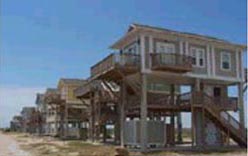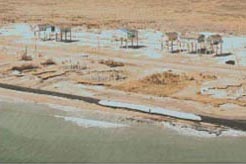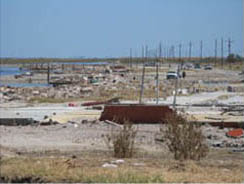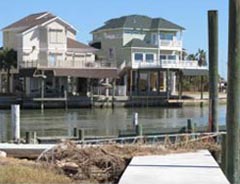
Complete General Contractors, Inc., in its role as an information service provider to the insurance industry, has seen the extensive damage to houses and commercial buildings caused by large, natural disasters. The impact of Hurricane Ike on the Texas coast provided researchers with a valuable opportunity to observe the real-world performance of building materials, product standards and construction techniques. It also provided the first performance test of homes constructed to building code-plus criteria outlined by the Institute for Business & Home Safety’s (IBHS) Fortified…for safer living program. The program provides design and construction requirements to make homes more resistant to natural disasters common in the location where they are built. disastersafety.org

According to the new report of property damage caused by Hurricane Ike by the IBHS, the minimum flood elevation requirements for properties vulnerable to storm surge throughout the Gulf Coast region are inadequate. The study, HURRICANE IKE: Nature’s Force vs. Structural Strength, shows that considerably more Gulf Coast homes and businesses are damaged by disastrous flooding from storm surge than previously recognized by property owners and policymakers.
“Lessons learned from Hurricane Ike, which is the third-costliest hurricane on record, should be used by vulnerable communities from Texas to Maine to effectively reduce property damage in all hurricane-exposed areas,” said IBHS President and CEO Julie Rochman.
According to IBHS Senior Vice President of Research and Chief Engineer Dr. Tim Reinhold, most homes in coastal areas are built to or slightly above 100-year base flood elevations. “A 100-year flood means that the level of flood water has a 1 percent chance of being equaled or exceeded in any single year. However, it is well recognized in the engineering community that coastal homes built to this level have a 26 percent chance of being flooded or demolished over the life of a 30-year mortgage. This chance increases to about 40 percent in a 50-year period,“ Dr. Reinhold said. “The chances of destruction can be significantly reduced by employing what has been learned about the importance of proper elevation, which can be relatively inexpensive when building a coastal home,” Reinhold says. www.claimsjournal.com

Some policyholders who own slabbed homes in the Bolivar Penninsula and surrounding areas are still waiting for their settlement from the state created TWIA (Texas Windstorm Insurance Association). The TWIA decided that they would pay 11.2 percent of the damage. They arrived at 11.2 percent by using a statistical and engineering model. The statistical model examined hundreds of houses still standing after Ike, measured the damage they sustained and then categorized the houses based on age, roof types, elevation above sea level, construction and other factors. A statistician then ran the information through a model to estimate how much damage each slabbed house likely sustained.
Jim Oliver, TWIA’s director, said the association has been in constant contact with policyholders and made offers on about a third of the 3,200 claims on leveled homes.
The association has also made advance payments to homeowners amounting to 10 percent of their dwelling coverage and 5 percent of their contents coverage.
“The misnomer out there is that 11.2 percent is a set number. It’s not,” he said. “It’s a high end of a range. We’ve told a lot of these folks we don’t believe 11.2 percent of the damage was caused by wind, but we’ll pay the higher amount.”
TWIA only has $2.1 billion available to pay for claims estimated at twice that amount. They have 142,566 policies and $42 billion in exposure in the Texas counties most affected by Ike.
This means it will more than likely make up the difference by turning to private insurance companies, which in turn will pass the costs on to property owners from Amarillo to Galveston.
Board members voted to raise $430 million by assessing private companies, $200 million of which will be used to pay premiums to keep the association’s reinsurance in effect.
“TWIA is wiped out. It’s naked,” said Rep. John Smithee, R-Amarillo, chairman of the House Insurance Committee. “I think it’s pretty clear there could be more assessments.”
Houston Chronicle www.chron.com
Slabs under homes along the coast are now also being questioned. Many coastal engineers very much oppose large concrete slabs being poured under elevated coastal homes. It is possible to have significant undermining of the slab, which would require demolition of that slab. In some cases, the loads the slab imposes on the structure could pose a significant risk to the structure itself. The clear preference is for large concrete segments that are essentially giant pavers. These could be moved about by the surge, and then replaced after soil/sand under the house is replaced and compacted. www.disastersafety.org.
This proves the importance of enacting and enforcing strong, appropriate building codes and proper elevation requirements in houses along coastal areas. The flood policy or elevation certificate states where you are in relation to sea level, grade at time of measurement and from floor to floor pre or post FIRM .Site inspection is very important. Pre or Post FIRM site inspection will establish the coverage. The flood line will obtain measurements from grade. A surveyor maybe needed to obtain an elevation certificate to establish your Finished Floor Elevation (FFE).Timing of permitting of repair will determine elevation requirements as municipalities adopt local codes and accept the maps drawn by FEMA for the local flood plain.

Complete has worked on numerous catastrophe claims throughout the Southeast and knows the importance of code and elevation requirement for coastal structures. Please visit our website at teamcomplete.com for more information and resources. If you would like more information on the article HURRICANE IKE: Nature’s Force vs. Structural Strength, please visit the above referenced websites.
This information should not be substituted for professional legal advice; consult with your lawyer for legal advice and ask your insurance professional to discuss the details of your policy and insurance needs.